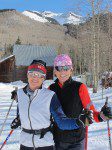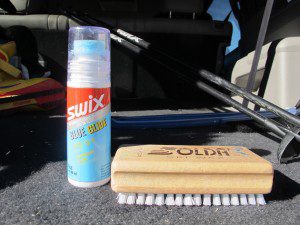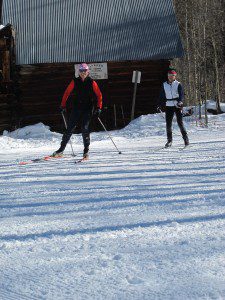
07 Jan SNOW SUNDAY: IMPROVE YOUR SKATE SKIING
 “It’s unbelievable how much you don’t know about the game you’ve been playing all your life.” Mickey Mantle
“It’s unbelievable how much you don’t know about the game you’ve been playing all your life.” Mickey Mantle
Substitute sport for game in the above quote, and Mantle pretty much nailed my naivety about skate skiing. For the past fifteen or so years, I’ve always owned a pair of skate skis — probably the same pair. I take them to Town Park, the Valley Floor or Priest Lake and muscle my way around for a while, thinking that I’m actually skate skiing.
Yes, from the blind observer, I can play the part (tight lycra pants and an old-school beanie help). But, I have never actually worked on my technique; I have never broken down my glide or practiced “drills” to improve.
All of that changed last week after skiing with Nordic Association President, certified skate-skiing instructor and overall bad-ass, Lois Major and her equally addicted skate-skiing friend, Thalia Pryor, (Thelma and Louise). After about 10 minutes with the pair, I realized I was pretty much a hack. So, I sucked up their advice, practiced their drills and left the session with a handful of exercises and technical tips that will truly take my skate skiing to the next level.
Here’s what I learned. See the video below for demonstrations of each drill.
1. Wax Your Skis. I knew to keep up with Major and Pryor, I would need every advantage I could get. So, I asked Major if she had any rub-on-wax. “Oh, My Gosh, we’re going to start at the beginning with you,” she said. Then she asked if the bases of my skis were white. Indeed they were.
Major first started brushing my skis with a nylon, Swix brush to open the grooves, and then swiped them with rub-on, Swix
Glide wax. “It’s like mouth to mouth resuscitation,” she said as she worked the wax into my dry bases.
In addition to rub-on wax, Major recommends hot-ironing regular alpine wax onto Nordic skis to keep the bases fast.  Midnight, who works for the Nordic Association at the little house in Town Park, is the go-to guy for hot waxing, and according to Major, most stores that carry Nordic gear in town, will carry rub-on wax.
Midnight, who works for the Nordic Association at the little house in Town Park, is the go-to guy for hot waxing, and according to Major, most stores that carry Nordic gear in town, will carry rub-on wax.
2. Warm-Up With No Poles. The first thing Major made me do was lose my poles. “People rely on their arms too much,” she explained. As we skated a few mini-loops without poles, she encouraged me to think about riding a flat ski and to start each glide from the same symmetrical point. To do this, she suggested picking a groove or line in the snow and trying to follow it, beginning each alternative glide from the line.
“You always want to be on a flat ski,” she said. “Don’t languish in the middle,” meaning, don’t get caught with your weight stuck in the middle, use it in your alternate diagonal glides.
Major noted that your body position should be like “you’re holding groceries in front of you or like a gorilla,” a little rounded with your core engaged. Skating with no poles will force you to work on maintaining a balanced position and to use your legs more.
3. Step To The Inside Around Turns. I chased Major around our loop and saw her expertly step around a tight corner and then transition right back into her skating rhythm. She didn’t slide, or seem to lose any speed. She explained that you need to step to the inside as you take corners and suggested reaching toward the inside, with your outside hand, as you corner to force your body to follow your skis and to prevent yourself from sliding sideways.
4. Get Out of V-1 and Find Your V-2. After our warm-up it was time to ski. We headed up the Priest Lake railroad grade and
Pryor abruptly stopped. “You need to be doing V-2,” she said.
“Okay,” I agreed, then asked, “What’s that?”
 V-1 is the first skating technique folks learn, and if you’re like me, you just keep doing it. It’s the loping rhythm, where you plant both of your poles, push and skate in one direction, push the opposite ski in the other direction without a pole plant and repeat.
V-1 is the first skating technique folks learn, and if you’re like me, you just keep doing it. It’s the loping rhythm, where you plant both of your poles, push and skate in one direction, push the opposite ski in the other direction without a pole plant and repeat.
V-2, I learned, is faster. Your body is symmetrical, and faces forward. You pole with every glide, both sides. Glide, plant, glide, plant, versus plant glide, glide, plant, glide glide.
5. Pole Down, Not Back. Major pointed to the double track and said sometimes she gets in there and poles her way back up the railroad grade. In essence, she is doing the exact opposite drill of skiing with no poles. In this drill, she doesn’t kick her feet, but relies solely on double-poling to propel herself forward.
When poling, she reminds me to focus on pushing down, and not back. Poling in the track also forces her to use her core.
6. Loosen Your Grip. To improve my skate skiing, Major and Pryor showed me it’s all about efficiency. “So, why bring your arms all the way back?” Major asked. After each pole plant, Major suggests letting your arms fall back, just to your hips or a little behind, then bringing them forward again. There is no reason to fling them back any further, she said. And, although she has her pole grips fastened tightly around her hand, each time her poles fall behind her, she lets go of her actual grip on them a little, before initiating the next glide and plant.
7. Get Out and Do It. Major and Pryor focus on their technique because it’s fun for them and they simply love Nordic skiing. “We skied for years without waxing our skis and only skating in V-1,” Pryor said. But then, like me, one day Thelma and Louise wondered if they learned a few things, and improved their technique, could they get a little better and faster?
From what I saw skiing with them at Priest Lake, the answer is a definite “yes”.
8. Check Out the Nordic Association Clinics. In addition to bringing your skis to Midnight for waxing tips, become a member of the Nordic Association and check out their clinics that range from everything to beginning Classic Skiing to Race-Ready Skating Clinics.


Emily Shoff
Posted at 21:19h, 09 JanuaryJess– I just finally got a moment to watch this. These are great tips, and I will definitely be trying them out on the track soon!